Written by Petra Marquardt-Bigman
From my home on the southern outskirts of Tel Aviv, I hear the Muslim call to prayer every day as it issues from a mosque half a mile away in neighboring Jaffa. Jewish Israelis see Arabic on their money, on street signs, on buses, and on the labels adorning foodstuffs that provide consumers with nutritional information. They hear Arabic in the stores, shopping malls, and cafes they routinely frequent. And if they visit a clinic or hospital, Jewish Israelis will hear Arabic spoken by their fellow patients, and by the doctors and nurses who tend to them. Israel may be the world’s only Jewish state, but Arabs account for roughly 21 percent of its population, so the sounds and sights of the Arabic language are simply part of daily life in this corner of the Levant.
So I was surprised to learn, from an article written by Michael Humeniuk for Quillette, that “when Jewish Israelis hear spoken Arabic, which they perceive as screams, they don’t know if a bomb is about to go off or one guy is simply complimenting another guy’s shoes.” Humeniuk is from Toronto, and his article is a well written and (presumably) well intentioned attempt to look beyond the “solemn stereotypes” he and other Westerners have absorbed of Palestinians “as freedom fighter or terrorist—geopolitical character actors within the grand narrative of what is vaguely described as ‘the Middle East conflict.’” Others, like him, who have travelled to Middle East because they are “touched and troubled by the plight of the Palestinians,” are so preoccupied by the politics of the conflict that they forget to notice “the Palestinian people themselves—how they cook and eat, how they tease and flirt, how they celebrate and mourn.” It is to this unenlightened view that Humeniuk wishes to offer a corrective.
Unfortunately, as Humeniuk relates his experiences in Palestine’s de facto capital, it becomes increasingly evident that he knows little about the region, its people, or its complexities. And so his lesson (audaciously entitled “Ramallah for Beginners”) soon lapses into tiresome clichés that contrast a heavily fortified and paranoid Israeli state with a portrait of peaceable donkey-riding Palestinians quietly tending their picturesque olive groves or enjoying the city’s party life (“cheaper and more welcoming,” we are told, than that offered by Tel Aviv). This perspective not only misunderstands the fraught history and political present of the region, but it unhelpfully caricatures Israeli Jews and Palestinian Arabs on both sides of the Green Line that separated Israel and the Jordanian-annexed West Bank before the Six Day War of 1967.
Read the rest of the essay, at Quillette, here.





